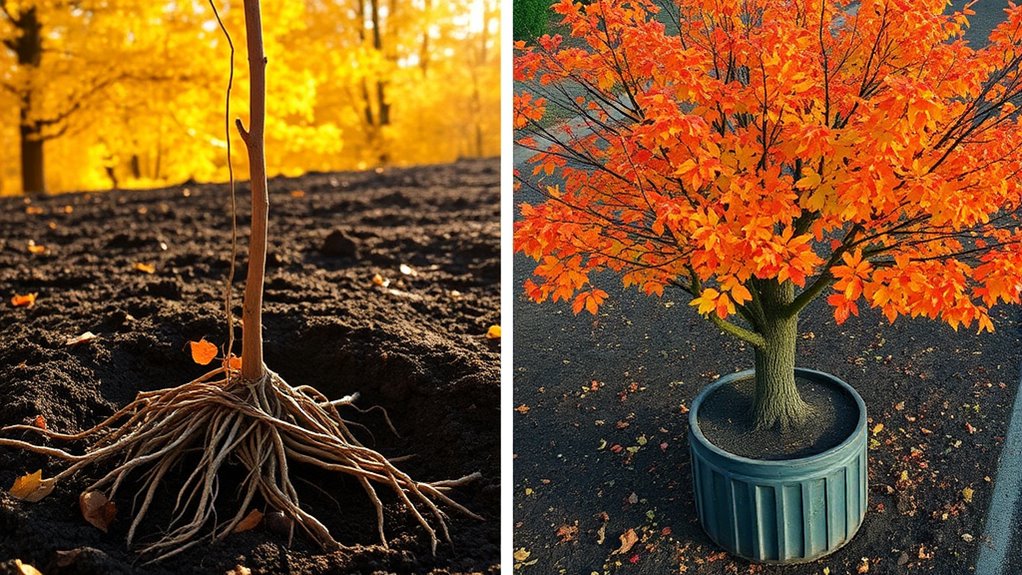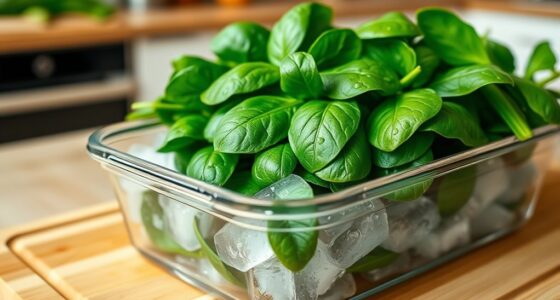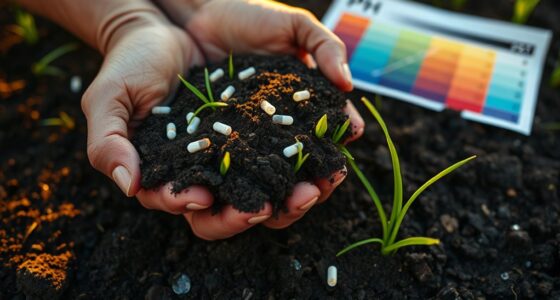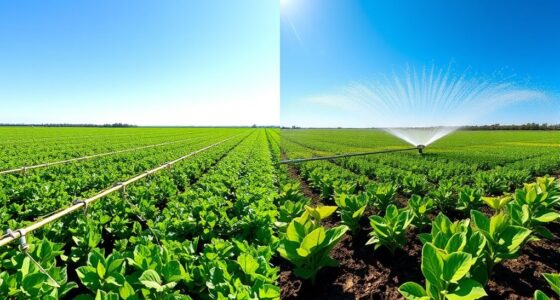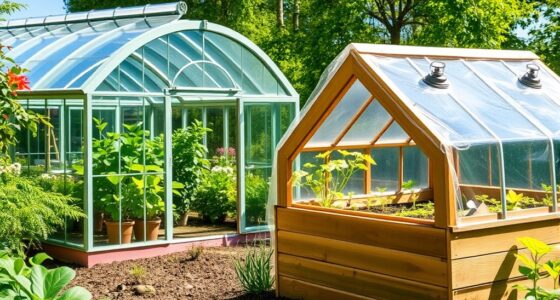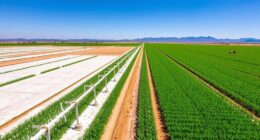Fall planting offers two main options: bare-root and container trees. Bare-root trees are lighter and cheaper but need careful handling to prevent drying out and are best planted while dormant. Container trees are easier to plant, show root health clearly, and adapt better to various soils, though they may be more expensive. Choosing the right type depends on your landscape goals and conditions—you’ll discover key tips and benefits as you explore further.
Key Takeaways
- Bare-root trees are planted while dormant for faster root establishment but need careful handling to prevent drying out.
- Container trees can be planted anytime, offering immediate stability and easier handling during fall planting.
- Bare-root options are cost-effective and promote quicker adaptation in suitable soil conditions.
- Container-grown trees allow for root system assessment and are better suited for less ideal soil types.
- Proper site preparation, watering, and mulching are essential for success with either planting method in fall.
Understanding the Basics of Bare-Root and Container Trees
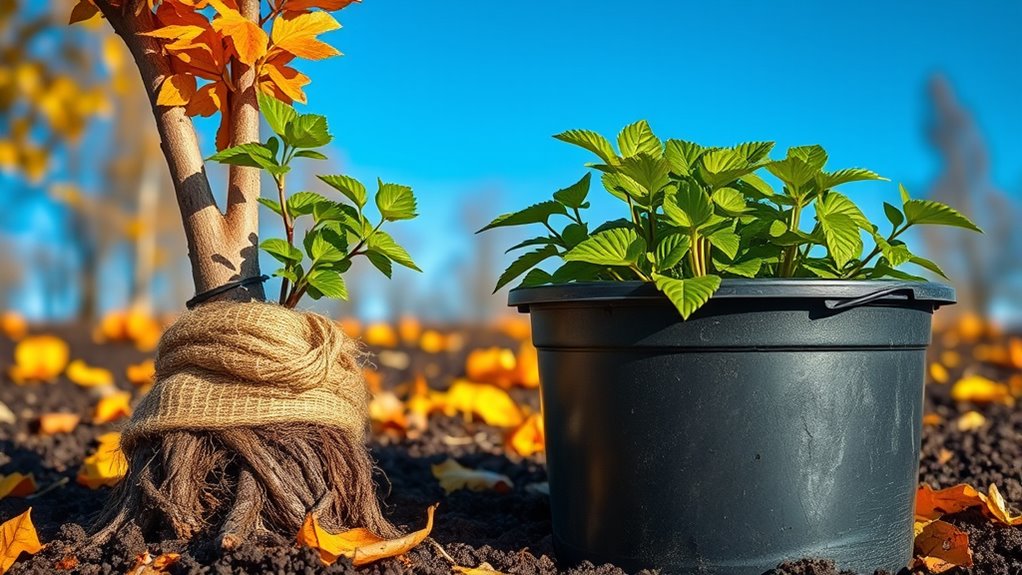
Have you ever wondered about the differences between bare-root and container trees? Bare-root trees are sold without soil around their roots, meaning they require careful handling for root establishment. They’re typically planted when dormant, helping roots adapt quickly to the new environment. Container trees, on the other hand, come potted in soil, which provides immediate stability and easier handling. When choosing between them, consider soil compatibility; bare-root trees need well-draining soil to promote healthy root growth, while container trees can tolerate a wider range of soil types. Bare-root planting usually results in faster root establishment, but requires precise timing and technique. Container trees offer convenience and instant greenery, especially in less-than-ideal soil conditions. Proper planting techniques are essential for ensuring healthy tree establishment and growth. Additionally, understanding the types of trees suited for fall planting can increase your success rate. Proper site selection can further improve your planting results and long-term health of your trees. For optimal growth, consider irrigation and watering practices tailored to your specific tree type and soil conditions. Using the right electric tools can also make planting and maintenance more efficient and less labor-intensive.
Benefits and Challenges of Bare-Root Trees in Fall Planting

Planting bare-root trees in fall offers several notable benefits, such as faster root establishment and cost savings. Since the root to soil contact is direct, trees adapt quickly, reducing transplant shock. However, challenges exist; bare-root trees are more vulnerable to drying out and require careful handling to prevent root desiccation.
| Benefit | Challenge | Solution |
|---|---|---|
| Faster root to soil | Increased drying risk | Keep roots moist during transport |
| Cost-effective | Sensitive to weather | Plant during mild conditions |
| Quicker establishment | Transplant shock potential | Proper planting depth |
| Easier to handle | Limited transplant window | Time planting carefully |
Advantages and Limitations of Container Trees During Autumn
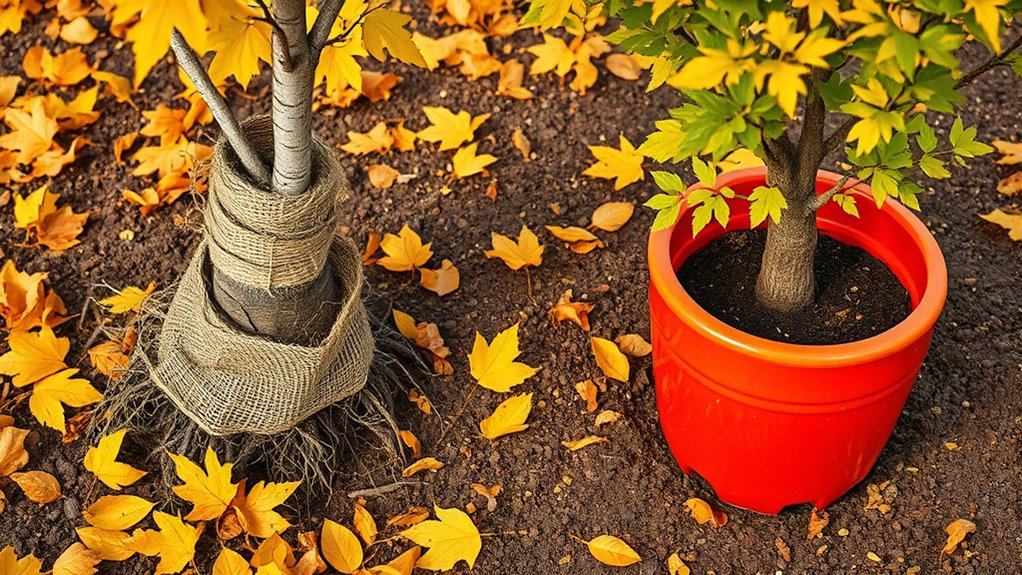
Container trees during autumn offer distinct advantages, especially their ease of handling and immediate visual assessment of root health. You can quickly evaluate root establishment and choose healthy specimens, ensuring better survival rates. Additionally, container trees often adapt better to various soil types, as you can select soil with suitable soil compatibility for the species. Proper installation techniques are essential to ensure healthy growth and development. Moreover, inspecting the root system before planting can help prevent potential issues such as circling roots. Being able to manage soil quality effectively is another benefit, as it allows for tailored conditions that support the tree’s needs. The ability to transport trees easily makes them especially appealing for autumn planting projects. However, limitations exist: the root system may be restricted by the container, leading to potential circling roots that hinder growth. Also, you might face transplant shock if roots are disturbed during planting. Keep in mind that container trees can sometimes be more expensive and require careful handling to prevent damage. Overall, their convenience and flexibility make them a popular choice, provided you pay attention to root health and soil conditions.
Tips for Successful Planting and Care for Both Types
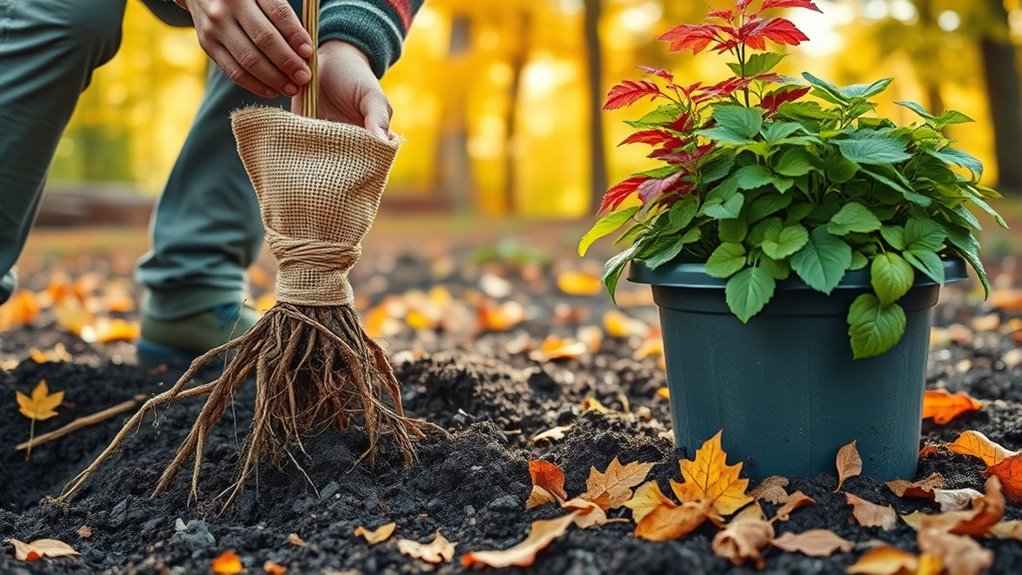
To guarantee successful planting and care of both container and bare-root trees in autumn, start by preparing the site properly. Ensure the soil is well-draining and matches the tree’s soil compatibility needs, which promotes healthy root establishment. Loosen the soil to encourage roots to spread easily and remove weeds or debris that could hinder growth. When planting, dig a hole twice as wide as the root ball or roots, and set the tree at the correct depth. Water thoroughly after planting to settle the soil and eliminate air pockets. Mulch around the base to retain moisture and regulate temperature. Monitoring soil conditions regularly helps prevent issues and promotes healthy growth. Incorporating proper soil preparation techniques can significantly improve the success rate of your planting efforts. Support your trees during the establishment period by providing adequate water and protection from harsh conditions until they are well-established.
Making the Right Choice for Your Landscape Goals

Choosing the right trees for your landscape depends on clearly defining your goals and understanding how different species can meet them. Consider whether you want rapid root establishment, drought tolerance, or aesthetic appeal. Selecting trees suited to your soil compatibility guarantees healthy growth and reduces transplant shock. Bare-root trees often establish roots faster in compatible soils, making them ideal if quick establishment is a priority. Container-grown trees can adapt to less-than-ideal soil conditions and are easier to plant in challenging landscapes. To make the best choice, evaluate your soil type, water availability, and long-term landscape vision. Additionally, understanding the planting method can influence the success and longevity of your trees. This way, you’ll select trees that thrive and help you achieve your landscape goals effectively. Proper soil preparation also plays a crucial role in ensuring healthy root development and overall tree vitality.
Frequently Asked Questions
How Do Soil Conditions Affect Tree Selection for Fall Planting?
Soil conditions greatly influence your tree selection. If your soil has good drainage and a neutral soil pH, you can choose a wider variety of trees, including those that prefer well-drained, slightly acidic or alkaline soils. However, if your soil drains poorly or has extreme pH levels, you’ll want to select trees adapted to those conditions. Matching your tree choices to your soil helps guarantee healthy growth and survival.
Are Certain Tree Species Better Suited for Bare-Root or Container Planting?
You might think all trees are equally suited for planting methods, but species suitability varies. For example, hardy species like oaks and maples adapt well to bare-root planting, offering quicker establishment. Conversely, delicate or less hardy species often grow better in containers, providing protection and better growth considerations. Choosing the right method depends on your tree’s specific needs, ensuring healthy growth and long-term success in your landscape.
What Are Common Mistakes to Avoid When Planting in Fall?
When planting in fall, avoid common mistakes like watering mistakes and timing errors. You might overwater or underwater, so make certain you keep the soil moist but not soggy. Plant too late or too early, risking frost damage or insufficient root establishment. Check weather forecasts and plant at the right time, ideally when the weather is mild, to give your tree the best start for healthy growth come spring.
How Does Fall Planting Impact Long-Term Tree Health?
Falling trees during autumn can benefit their long-term health by supporting healthy root development and adapting to seasonal growth patterns. You’ll help the tree establish a strong root system before winter, which is essential for survival. Proper fall planting encourages better nutrient uptake and resilience. Avoiding common mistakes like poor soil preparation or planting too shallow ensures your tree thrives long-term, fostering vigorous growth and stability as seasons change.
Can Fall Planting Be Successful in All Climate Zones?
Imagine planting a tree in fall and hoping it thrives everywhere—that’s a challenge! Fall planting success depends on climate zones, with some experiencing harsh winters or hot, dry conditions. Fall planting challenges vary, so seasonal planting strategies must adapt—using mulch or choosing hardy species. In cooler zones, fall works well, but in others, spring might be better. Know your climate to guarantee your tree’s long-term health.
Conclusion
So, whether you opt for bare-root or container trees this fall, remember that the real challenge isn’t choosing the right type—it’s convincing yourself that either choice guarantees a thriving landscape. After all, nature loves a good irony: the more you plan, the more you realize how much depends on luck, timing, and a touch of patience. Happy planting, and may your trees flourish despite—or perhaps because of—your best efforts.

